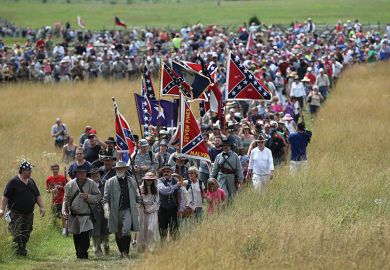Camerawork was a magazine-cum-journal published by an editorial collective of left-wing writers and photographers (including Jo Spence) in the East End of London between 1975 and 1985. Production standards were not especially high and its layout was decidedly ordinary. Yet the material it contained during this brief life was of far more than passing interest, though the claim made in this book, that "a perfect copy of issue one has become a collector's item valued at around Pounds 500'' is ironic but unfortunately misleading, probably a confusion with an earlier magazine of the same name, published at the turn of the century under the editorship of Alfred Stieglitz. Nobody collects old copies of the British Camerawork, though perhaps they should.
The later magazine seem about as far removed from Stieglitz's publication as could be imagined, though perhaps no more radical in intent. For a start, it wanted to disengage photography from any pretensions to the outmoded orthodoxies of the art tradition, and especially to the idea that photographers should imitate the "expressive individualism'' of the artist. As a magazine which published photographs as well as essays, the British Camerawork also represented the apogee of the community photography movement of the 1970s: an offshoot of the "concerned photography'' genre which involved the (frequently collective) making of pictures which served working-class interests as part of a wider political agenda. Making images was a way of empowering those disenfranchised by class, race, ethnicity or gender. But the linking of politically inspired image-makers and cultural critics was a fatal combination, as the writers ended up by undermining what the photographers were trying to do.
Stieglitz's Camerawork wanted to make photography into an elitist fine art. The later publication was initially quite anti-elitist, one of the few UK magazines to deal with the ideological, critical and contextual study of photography. Despite the political agendas of the photographers who supported the magazine, Camerawork is largely remembered for its seminal writing about the medium, much of it spun off from the emergent concerns with popular culture in sociology and the fledgling field of cultural studies. Semiotics and applications of Foucauldian discourse theory are much in evidence in the later issues.
As Jessica Evans's careful selection shows, those who wrote for it wanted to explore the "practices, genres and environments'' of the medium. The issues with which they engaged are marked by the zeitgeist of the politics of the 1970s and 1980s - feminism, photo-therapy, advertising, Nicaragua, the successive electoral failures of the left. Evans has included several important pieces of writing from the heyday of Camerawork when it turned towards the politics of representation, and has encouraged many of the contributors to provide a new introduction to their essay, which both updates and contextualises the argument. The range of writers is wide, from John Berger, to Stuart Hall, John Tagg, Don Slater, David Mellor, Kathy Myers and Victor Burgin.
The trend of the writing runs against any notion that photographs can tell us anything reliable about the social world. One of the only essays not to take this line is by Berger for whom documentary photography of the sort created in his collaborations with Jean Mohr, would help to better understand their subjects; a country doctor, immigrant workers, alpine peasants, etc. But for many of the other writers, analysis of the act of making documentary images led them to espouse a nihilistic idea of representation, so that no photographic image could in any sense by considered realistic.
It seems that as the critique of photographic representation developed in Camerawork, it became increasingly hostile to what its writers understood as the assumptions underlying "documentary'' photography - which of course formed the raison d'etre of the "community photographers'' who were the other constituency for the magazine. Middle-class photographers taking "sentimental'' pictures of working-class people were in the firing line, and by the early 1980s no politically committed photographer associated with the magazine felt able to take a picture of another person. The alternative was to make images of dolls, or better still their own bodies, a cultural turn which fitted in terribly neatly with the politics and poetics of identity, then emerging as a key theme in "fine'' art.
There is no doubt that the demise of Camerawork coincided with a strategic turn in cultural studies, as in the arts generally which have generated a new elitism and orthodoxy centred on the personal and the politics of representation. It is ironic that the drift of Camerawork's critique has led to a position where fine art has appropriated both photography and the politics of identity to such an extent that more democratic and realistic forms of the medium are once more excluded from contemporary art - much as they were a century ago.
Peter Hamilton is lecturer in sociology, Open University.
The Camerawork Essays
Editor - Jessica Evans
ISBN - 1 85489 080 8 and 081 6
Publisher - Rivers Oram
Price - £30.00 and £12.95
Pages - 264
Register to continue
Why register?
- Registration is free and only takes a moment
- Once registered, you can read 3 articles a month
- Sign up for our newsletter
Subscribe
Or subscribe for unlimited access to:
- Unlimited access to news, views, insights & reviews
- Digital editions
- Digital access to THE’s university and college rankings analysis
Already registered or a current subscriber? Login



